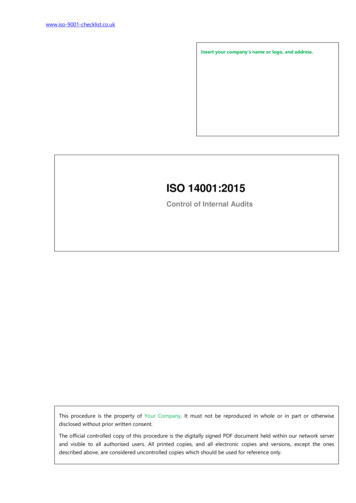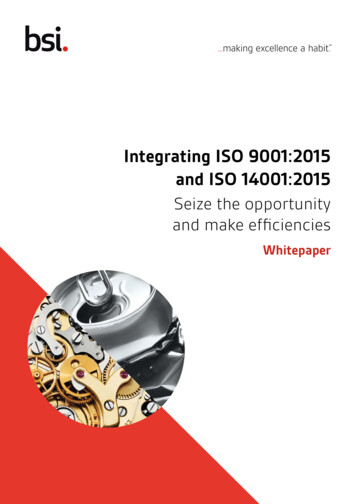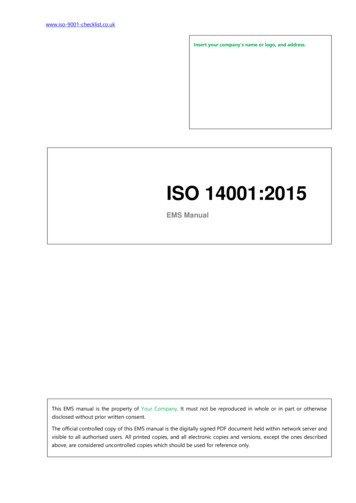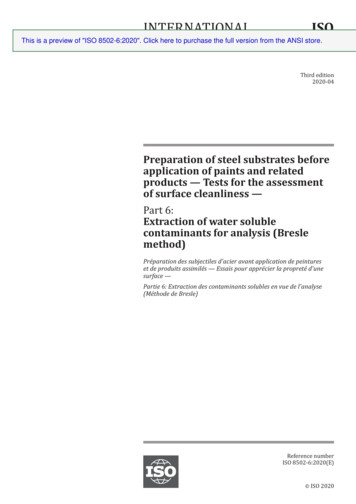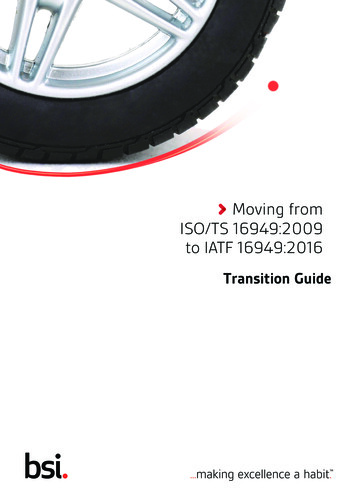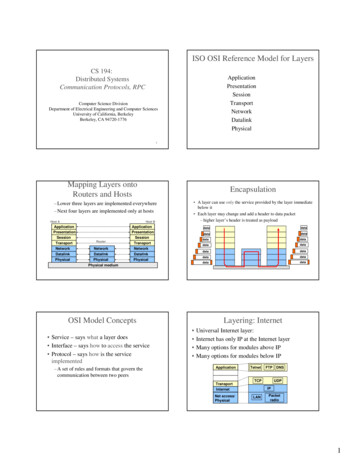
Transcription
ISO OSI Reference Model for LayersCS 194:Distributed SystemsCommunication Protocols, atalinkPhysicalComputer Science DivisionDepartment of Electrical Engineering and Computer SciencesUniversity of California, BerkeleyBerkeley, CA 94720-17761EECS122 - UCBMapping Layers ontoRouters and HostsEncapsulation– Lower three layers are implemented everywhere– Next four layers are implemented only at hostsHost AHost BApplicationPresentationSession A layer can use only the service provided by the layer immediatebelow it Each layer may change and add a header to data packet– higher layer’s header is treated as linkPhysicaldatadatadatadatadatadataPhysical mediumOSI Model Concepts Service – says what a layer does Interface – says how to access the service Protocol – says how is the serviceimplemented– A set of rules and formats that govern thecommunication between two peersLayering: Internet Universal Internet layer:Internet has only IP at the Internet layerMany options for modules above IPMany options for modules below IPApplicationTransportInternetNet access/PhysicalTelnetFTPTCPDNSUDPIPLANPacketradio1
ApplicationTransportNetworkInternet’s HourglassPhysical rApplication Layer Service: move information between two systemsconnected by a physical link Interface: specifies how to send a bit Protocol: coding scheme used to represent a bit,voltage levels, duration of a bit Examples: coaxial cable, optical fiber links;transmitters, receiversNetwork LayerDatalink LayerPhysical rtNetworkDatalink LayerLinkPhysical Service:– Framing (attach frame separators)– Send data frames between peers– Medium access: arbitrate the access to commonphysical media– Error detection and correction Interface: send a data unit (packet) to amachine connected to the same physical media Protocol: layer addresses, implement MediumAccess Control (MAC) (e.g., CSMA/CD) ApplicationTransportNetworkLinkPhysicalNetwork LayerLinkPhysicalDatagram (Packet) Switching Service:– Deliver a packet to specified network destination– Perform segmentation/reassembly– Others Packet scheduling Buffer management Interface: send a packet to a specified destination Protocol: define global unique addresses; constructrouting ram (Packet) SwitchingHost CHost CHost DHost Arouter 1Host DHost Arouter 1router 2router 2router 3router 3router 5router 5Host Brouter 6router 4router 7Host EHost Brouter 6router 7Host Erouter 42
ApplicationTransportNetworkTransport LayerLinkPhysicalEnd-to-End View Services: Process A sends a packet to process B– Multiplex multiple transport connections to one networkconnection– Provide an error-free and flow-controlled end-to-endconnection– Split one transport connection in multiple networkconnections Interface: send a packet to specify destination Protocols: implement reliability and flow control Examples: TCP and UDPEnd-to-End Layering ViewProc. A(port 10)dataTransportdata107data107data107 16.25.31.10 128.15.11.12data107 16.25.31.10 128.15.11.12Physical16.25.31.10Proc. B(port 7)a)b)Normal operation of TCP.Transactional TCP.2-4Proc. B(port 7)dataInternetProc. B(port 7)128.15.11.1216.25.31.10128.15.11.12Proc. A(port 10)NetworkDatalinkInternetClient-Server TCPInternet16.25.31.10Proc. A(port ventional Procedure CallExample: Local Procedure CallMachineProcess.n sum(4, 7);.a)b)sum(i, j)int i, j;{return (i j);}Parameter passing in a local procedure call: the stack before thecall to readThe stack while the called procedure is active3
Example: Remote Procedure CallStubsClientClient and Server Stubs Principle of RPC between a client and server program.ServerProcessProcess.n sum(4, 7);.OSmessagemessagesum47sum47sum(i, j)int i, j;{return (i j);}OSSteps of a Remote Procedure Call1. Client procedure calls client stub in normal way2. Client stub builds message, calls local OS3. Client's OS sends message to remote OS4. Remote OS gives message to server stub5. Server stub unpacks parameters, calls server6. Server does work, returns result to the stub7. Server stub packs it in message, calls local OS8. Server's OS sends message to client's OS9. Client's OS gives message to client stub10. Stub unpacks result, returns to clientDifferent EncodingsParameter Passing Server and client may encode parameters differently– E.g., big endian vs. little endian How to send parameters “call-by-reference”?– Basically do “call-by-copy/restore”– Woks when there is an array of fixed size– How about arbitrary data structures?Parameter Specification and Stub Generationa)b)a)b)c)A procedureThe corresponding message.Original message on the PentiumThe message after receipt on the SPARCThe message after being inverted. The little numbers inboxes indicate the address of each byte4
Binding a Client to a Server Client-to-server binding in DCE.Doors The principle of using doors as IPC mechanism.2-15RPC Semantics in the Presence of Failures The client is unable to locate the serverThe request message from the client to server is lostThe reply message from the client is lostThe server crashes after sending a requestThe client crashes after sending a requestClient is Unable to Locate Server Causes: server down, different version of serverbinary, Fixes– Return -1 to indicate failure (in Unix use errno toindicate failure type) What if -1 is a legal return value?– Use exceptions Transparency is lostLost Request Message Easiest to deal with Just retransmit the message! If multiple message are lost then– “client is unable to locate server” errorLost Reply Message Far more difficult to deal with: client doesn’t knowwhat happened at server– Did server execute the procedure or not? Possible fixes– Retransmit the request Only works if operation is idempontent: it’s fine to execute ittwice– What if operation not idempotent? Assign unique sequence numbers to every request5
Server Crashes Two cases– Crash after execution– Crash before execution Three possible semantics– At least once semantics Client keeps trying until it gets a replyClient Crashes Let’s the server computation orphan Orphans can– Waste CPU cycles– Lock files– Client reboots and it gets the old reply immediately– At most once semantics Client gives up on failure– Exactly once semantics Can this be correctly implemented?Client Crashes: Possible Solutions Extermination:– Client keeps a log, reads it when reboots, and kills the orphan– Disadvantage: high overhead to maintain the logRPC Semantics: Discussion The original goal: provide the same semantics as alocal call Reincarnation:––––Divide times in epochsClient broadcasts epoch when rebootsUpon hearing a new epoch servers kills the orphansDisadvantage: doesn’t solve problem when network partitioned Impossible to achieve in a distributed system– Dealing with remote failures fundamentally affectstransparency Expiration:––––Each RPC is given a lease T to finish computationIf it does not, it needs to ask for another leaseIf client reboots after T sec all orphans are goneProblem: what is a good value of T?Asynchronous RPC (1) Ideal interface: balance the easy of use with makingvisible the errors to usersAsynchronous RPC (2) A client and server interacting through twoasynchronous RPCs2-12a)b)The interconnection between client and server in atraditional RPCThe interaction using asynchronous RPC6
ISO OSI Reference Model for Layers Application Presentation Session Transport Network Datalink Physical Mapping Layers onto Routers and Hosts – Lower three layers are implemented everywhere – Next four layers are implemented only at hosts Application Presentation Session Transport Network Datalink Physical Application Presentation Session Transport Network Datalink


